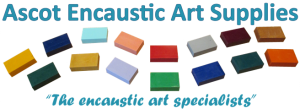Encaustic
What is Encaustic Art? In the modern world it tends to refer to any work where wax is used in the painting process.
Although the word Encaustic is thought to be derived from an ancient Greek word, said to mean “to burn in”, it did used to be used in a cold form as well as heated.
Pre-dating tempera & oils, as far back as 800 B.C. Homer was said to refer to the painted ships the Greek warriors had when they fought at Troy. This is believed to have happened when the Greeks waterproofed their bots with a mixture of wax & resin and someone then decided to mix colour pigments to the mix giving rise to the decorated ships.
Perhaps the most famous examples of encaustic art occurred from the 1st through to the 3rd century A.D. known as the Fayum Mummy Portraits, examples of which still exist today and can be seen at the Cairo Museum.
This was where a large number of Greeks settled in Egypt eventually took up the local custom of mummification and had portraits painted (usually while still alive) to be placed on their mummy as a memorial. These were painted on wood (normally limewood) or linen fabric.
It is also said that many of the wall decorations in the temples in Egypt were done with encaustic.
With the advent of tempera painting, encaustic as a more cumbersome process died out to a great degree, although there were revival attempts at various times especially around the 18th century, however it was not really until the 20th century, with the advent of ease of electricity that the new wave of encaustic came into being.
Now it is becoming a widely practiced medium, with two distinctive Techniques being practiced, referred to as the “European” and the “North American” and while Lynn started working in the “European” style, she now encompasses both of these and in fact in many of her pieces combines the two to great effect.


